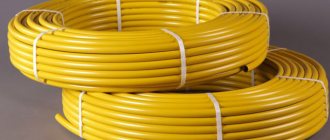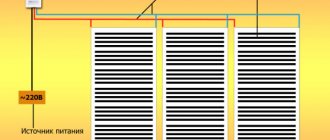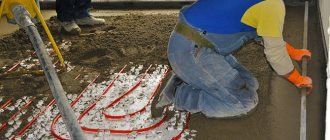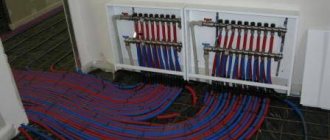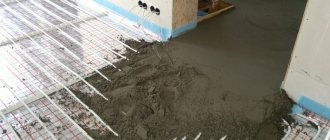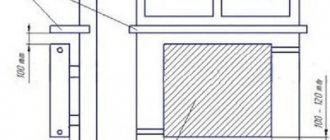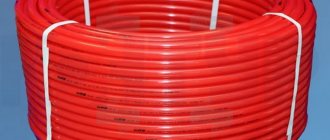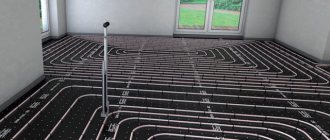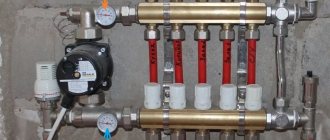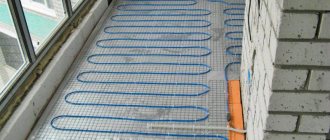Today, having a heated floor in a house or apartment is far from a luxury and not uncommon. Any owner of a private house or apartment can easily buy and install it, either independently or with the help of specialists (depending on the type and method of fastening the heated floor pipes). Most often, people install such floors not for their own comfort, but for their children. In addition, the heat from the floor is evenly distributed over the entire area of the room in which it is installed. Nowadays, in markets and specialized stores, customers are presented with a wide range of different heated floors. Their differences are only in price and installation method.
Construction of polyethylene pipe
Reinforcement.
Almost all cross-linked polyethylene pipes have a complex multilayer structure. It could be:
- polypropylene;
- fiberglass;
- aluminium foil;
- perforated aluminum;
- solid aluminum sheet.
The reinforced layer is able to neutralize sudden pressure changes inside the PE-S pipe when used in a hot water or heating system.
The design of cross-linked polyethylene products provides for the presence of a reinforced layer both on the surface of the product and at various depths. If it is necessary to solder two or more pipes, the reinforcing layer is stripped to 1 cm.
Pipes made of cross-linked polyethylene for underfloor heating are practically not reinforced. This material is also called “pure”.
Oxygen barrier. The manufacturer also calls it a “diffusion barrier” or “anti-diffusion protection.” This layer is mandatory for all types of cross-linked polyethylene products.
The reason for its appearance in HDPE pipes is the ability of oxygen molecules to penetrate into the material through a three-dimensional lattice, as a result of which cross-linked polyethylene is slowly but surely destroyed.
The diffusion barrier can also be either inside or outside the pipe.
Briefly about the main thing
Penoplex is characterized by two properties. The first is its low thermal conductivity, due to which it has good thermal insulation. Secondly, the slabs are not susceptible to mold and mildew; they create a good soundproofing layer, while rejecting moisture.
Another advantage is that penoplex is universal in use - it can be used regardless of the base flooring.
But here it is important to understand what thickness of penoplex to use for the floor under the screed. Further load on the surface (purpose of the room) has a huge impact.
If this is, for example, a warehouse or a garage where a car will be stored, it is better to choose denser slabs.
The type of finishing does not matter. It all depends on the preferences of the owner of the premises. You can choose laminate, tile, plywood or parquet.
Another mandatory point is waterproofing. If this layer is skipped or installed incorrectly, spilled water may accumulate under the finish coat. Penoplex does not absorb moisture, and it will be quite difficult to dry it.
Advantages and disadvantages
Using a special device, you can quickly secure pipes
The advantages of anchor brackets include:
- high speed and ease of installation of products in comparison with other methods;
- reliability of fastening of pipe blanks;
- durability;
- relatively low cost.
The fastening element can be used to fix other types of pipelines that are not related to heated floors. Due to the presence of protective plastic teeth, the products in question are highly resistant to impact loads. The disadvantages of fasteners of this class include the complexity of installation on some types of water and electric heated floors.
Attention! | Cloudflare
Why should I fill out a CAPTCHA?
Completing the CAPTCHA proves that you are a human and gives you temporary access to the web resource.
What can I do to prevent this from happening in the future?
If you're on a personal connection, such as at home, you can run an antivirus scan on your device to make sure it's not infected with malware.
If you are in an office or shared network, you can ask the network administrator to run a network scan for misconfigured or infected devices.
Another way to prevent this page from appearing in the future is to use Privacy Pass. You may need to download version 2.0 now from the Firefox Add-ons Store.
.
Collector connection diagram
The choice of a ready-made mechanical or automatic collector model depends on the characteristics of the heating system.
The first type of control module is recommended to be installed for heated floors without a radiator, the second can be used in all other cases.
Valtec collector groups are the most popular. The manufacturer provides a 7-year warranty on its products. The installation diagram for the liquid circuit manifold is already included in the package of the finished mixing unit
According to the diagram, the assembly of the distribution comb for heated floors is carried out as follows:
- Installation of the frame. The following can be selected as the installation area for the collector: a prepared niche in the wall or a collector cabinet. It is also possible to mount directly to the wall. However, the location must be strictly horizontal.
- Connection to the boiler. The supply pipeline is located at the bottom, the return pipeline is located at the top. Ball valves must be installed in front of the frame. They will be followed by a pump group.
- Installation of a bypass valve with a temperature limiter. After this, the collector is installed.
- Hydraulic test of the system. Check by connecting to a pump, which helps build up pressure in the heating system.
In a mixing unit, one of the required elements is a two- or three-way valve. This device mixes water flows of different temperatures and redistributes the trajectory of their movement.
Shut-off valves and fittings are installed on both pipelines, return and supply, connected to the manifold installation, designed to balance the volume of the coolant, as well as to block any of the circuits
If servo drives are used to control the manifold thermostats, then the mixing unit equipment is expanded with a bypass and bypass valve.
Recommendations for selection
Experts share some tips to help you choose the right option.
- If your apartment has an uneven or too cold floor, then you should think about installing a screed. For simple leveling, a self-leveling mixture is suitable.
- You can insulate a floor in different ways. In a private house there are more options for installing heated floors than in an apartment. Any redevelopment or similar work will require approval from other owners, housing organizations and regulatory authorities.
- When installing slab insulation on the floor, approval will not be required. Penoplex will be an excellent choice, because it is suitable for both tiles and laminate and other popular coatings. The only requirement is that the screed should not be thinner than 4 cm, otherwise it will soon begin to crack and crumble, which will inevitably lead to deformation of the floor finish.
- The choice of screed for a wooden house depends on the type of foundation. Wooden flooring will not withstand heavy loads, and it is the load resistance indicator that is the main factor when choosing the thickness of the screed. If a reinforced concrete slab is used as a subfloor, the mortar layer may be thicker.
- The thinnest screed in garages is comparable to the thickest screed in buildings. The ground screed cannot be thin. If the rough reinforced concrete floor needs to be leveled, the height of the screed layer can be reduced.
You can learn how to make a screed with your own hands from the video below.
Alternative options for mounting heated floors
To fix heated floors, not only a bracket is used, but also other devices:
- Mats with bosses do not require additional fastening. They are easy to install and fix, and their thermal insulation qualities are above average;
- Masonry reinforcing mesh for pipelines is fixed with plastic and metal clamps. The design is reliable and highly durable;
- If the base is made of foam plastic, then the pipes are secured with an anchor bracket;
- Concrete base requires perforated tapes during installation;
- Wooden floors are usually heated with pipes installed on wooden modules.
Mats with bosses
Advantages of using mats with bosses:
- You can make a concrete screed directly onto the mats without making a protective layer. Cement does not enter into chemical reactions with mats that have a protective film on the surface;
- Easy installation - modules are assembled by hand;
- Pipe fasteners are not required; the bosses on the plates themselves firmly fix the pipeline;
- The reverse side with a relief increases thermal insulation, noise protection, and also makes it possible to build the system on an unleveled base.
Reinforcing mesh
The concrete screed can be additionally strengthened with reinforcing masonry mesh. The design becomes several times more durable. To do this, the grid must be laid in a special sequence:
- Clamps made of plastic or silicone make the fastening easy and simple, so the installation of the pipeline will be completed in a few movements. Connections of this type are very reliable and do not break;
- The use of wire limits the installation process - strong tension should not be allowed, since there is a high risk of damage to the pipe;
- An iron clamp is a compromise between plastic clamps and wire. Iron fasteners are more expensive, but the installation process will be lengthy.
Having considered all the options, we can conclude that the installation of the water circuit pipeline is carried out on a reinforcing mesh using plastic clamps.
Method 1
Initial preparation of work
First, you need to inspect the foam sheets; do not use material that has uneven surfaces, otherwise it will not perform the desired function, and the installation itself is difficult. A thirty-centimeter layer of gravel or crushed stone is placed on the ground, compacted and sand up to 10 centimeters thick is poured. This layer is also compacted and a reinforced concrete screed with a thickness of 4 centimeters is constructed. To make it easier to install the floor, expanded clay is added to the ordinary solution if the screed is planned to be thicker than 10 centimeters. Then the floors are allowed to dry for up to two weeks, after which all unevenness is removed; when cracks appear, they are widened and covered again flush with the entire surface. In the next step, waterproofing is placed, you can take polyethylene, it has a low price and is able to perform its functions under high humidity and temperature changes. If necessary, other waterproofing materials are used.
Laying penoplex
The slabs are placed close to each other, the seams are glued together with a special tape or adhesive tape for construction so that moisture from the cement does not pass through the joints. When waterproofing, such actions need not be done. On the sides of the common perimeter, you can make a border with a deformation tape so that moisture from the foundation does not get onto the floors; under load and temperature changes, the tape compresses and expands, which prevents the surface from cracking. Another layer of waterproofing material is placed on top, and then foam sheets are laid out. After laying the penoplex is completed, screed again with a solution of cement and sand; instead, you can use a special construction mixture, do it strictly according to the liner. The thickness should be from 5 centimeters, with more planning, you can add expanded clay, it will lighten the weight of the concrete. At the same time, a mesh of reinforcement is laid to ensure good strength of the material. Then the final decorative covering is placed; it can be laminate, linoleum, parquet or other materials.
Installation technique
Heated floor pipes are mounted on insulation - polystyrene foam
The most common option for using anchor brackets is the fastening of heated floors with elements having a standard size of 16 mm. Laying the structure with their help is organized according to the instructions, which prescribe the following sequence of operations on polystyrene plates:
- The floor base is cleaned of accumulations of dirt and dust, as well as of debris remaining after construction work.
- The floor surface is carefully leveled, and excessive differences in height are eliminated using a self-leveling mixture.
- After setting, a layer of polyethylene film is laid on a flat surface, used as waterproofing protection.
- Its individual pieces are placed one under the other, and the overlap areas are then sealed with construction tape.
- The surface is laid with a standard edge strip, on top of which polystyrene mats are laid out with a slight offset.
- The latter are fastened together using a special type of locks.
- Directly on the surface of the polystyrene coating, the thermal circuit is laid out.
How to insulate a wooden floor
You can lay a layer of penoplex directly on top of the plank base if it is in good condition.
Sequence of actions for insulating floorboards:
- We remove the baseboards and finishing coating. Subsequent insulation should be carried out only after checking the quality of the lag. To do this, you need to remove a couple of boards and assess their condition. Any damaged areas with mold, black spots, or eaten away by insects must be replaced. If the logs are well preserved, you can nail the boards into place, and then check the horizontal position.
- The wooden base is leveled with a grinding wheel, and cracks and recesses are filled with wood putty.
- Next, the boards are treated with antiseptic primer and allowed to dry thoroughly. Very porous wood is covered with 2 or 3 layers of primer.
- Penoplex can be laid on a dry base. The laying method is similar to the previous one - the slabs are placed on glue, placing them apart. If gaps have formed between the plates, they should be foamed. The foam should not contain toluene, which destroys penoplex.
- A vapor barrier is laid over the insulation. The canvases are overlapped by 10 cm, and the edges should overlap the walls slightly. Subsequently, all excess will be removed.
- Next, lay a layer of plywood or particle board, spacing them halfway across the width of the canvas so that the seams do not converge in one place. During the installation process, it is necessary to control the level relative to the horizon. The laid surface should be absolutely flat.
- At the final stage, the final coating can be laid.
That is, insulating the floor with penoplex over joists is simply not advisable. Therefore, we recommend using cheaper materials for such a base, for example, mineral wool or polystyrene foam.
The mounting method depends on the base
The choice of method for attaching the circuit depends on the base under the pipes. Let us dwell on the options for bases and methods of attaching underfloor heating pipes.
Mats with bosses
Modular mats for laying heating elements
The use of mats with bosses provides the following advantages:
- The possibility of using a concrete screed over the mat without a special protective layer, since the cement will not react with the elements of the mat. The surface of the mat has its own protective film.
- Easy installation. Putting the modules together is not difficult.
- Simple pipe fastening. To secure the pipes, no fasteners are needed, since the slab bosses securely fix the pipes.
- Relief reverse. This provides several advantages at once: increased thermal insulation, sound insulation and the ability to use on uneven ground.
When using mats with bosses, there is no need to worry about how to attach the heating elements to the polystyrene foam.
Reinforcement mesh
A reinforcing mesh is laid on top of the concrete screed to add strength to the structure. When laying pipes on reinforcement mesh, the following fastening methods are used:
Fastening with plastic clamps is reliable and quick
- plastic clamps. Securing with silicone clamps is easy and simple, because the process of tightening the pipes takes place in a couple of deft movements. At the same time, the connections are reliable. It is impossible to break such a clamp.
- wire. Do not pull too hard, otherwise the pipe will be damaged.
- iron clamps. Average between the two previous methods, but it takes more time and the clamps are more expensive.
Conclusion: plastic clamps are suitable for attaching warm water floor pipes to reinforcement mesh.
Foam insulation
Anchor shackles
If the insulating layer consists of polystyrene boards, then special staples for a warm water floor made of plastic with pointed and hook-shaped teeth are used, which is why they are called anchors.
When using staples you need to be careful and careful. It is necessary to correctly calculate the distance between the pipes using foam plastic and only then proceed with fastening. It is not recommended to pull out staples and drive them into new places. It is possible to crumble and degrade the technical qualities of the thermal insulation material.
Concrete base
Often a concrete screed without an insulating layer is used as a base. In such cases, special perforated tapes are needed, which have special places in the structure for securing pipes. The profile is fastened to the concrete base with self-tapping screws, and the circuit of heating elements is attached to the fixing rail.
To attach pipes directly to a concrete base, use clips for warm water floors. A plastic clip is attached to the concrete using a self-tapping screw, and a pipe is placed on the clip. For example: if the pipe for a water heated floor is 16 mm, then the clip has a larger diameter and a cut-off arc for connection. Don't be alarmed if the pipe is slightly loose on the clip. The main thing is that the contour does not move during operation.
Conventional insulation with a system of wooden logs
Wooden modules
To heat wooden floor coverings, use a special wooden module that is installed on top of the joists. It turns out that a water circuit of the pipeline is laid on top of any type of insulation, securing the pipes to special wooden logs with grooves. And there is no need to rack your brains over the process of forming the contour, because the distances between the grooves have been calculated.
The fastening method is selected depending on the base for laying the pipeline. It is necessary to take into account all the nuances during the design process in order to complicate installation.
Insulation as a necessity
When working on thermal insulation of floors, it is necessary to take into account several important aspects that can have a serious impact on the final result, and most importantly, on the condition of the floor covering during operation. This:
- Condensate. Collecting on the floor surface, in places where it meets the walls, moisture can lead to an increase in humidity in the room, leading to the appearance and spread of mold and mildew.
- Environmentally friendly. Thermal insulation material must be “healthy” and therefore should not pose any harm to humans.
- If possible, be soundproof.
The biggest problem is, after all, the formation of condensation and everything connected with it. However, laying penoplex on the floor solves the problem! Plus, competent design and strict adherence to all recommendations are necessary.
Characteristics
Before you start gluing penoplex under the floor screed, you need to understand what characteristics this material has:
- Low water absorption. The material practically does not absorb moisture.
- High thermal insulation performance, as already noted, the material can reduce heat loss by 20%.
- High compressive strength.
- Small degree of deformation during compression.
- Long, almost unlimited service life.
Penoplex and moisture
As for the advantages, and they should be if we are talking about working with our own hands, then these are:
- Easy to install.
- Quick installation.
- No need for special knowledge.
Important! A separate line can be said about the cost of the material, which allows it to be safely used as insulation for large rooms. . Laying
Laying
Since penoplex has a closed-cell structure, it can be laid directly on a rigid base made of crushed stone, with a leveling layer of sand. This happens when we are talking about floor insulation in a private house under construction, and on the first floor.
Insulation material on a compacted surface
If we are talking about an apartment, then the material is laid using a slightly different technology, but, nevertheless, very simple (find out here how to insulate the floor in an apartment).
Due to its physical characteristics, and this is a fairly low weight, penoplex is very easily glued to the floor surface.
To do this you need:
- Carry out preparatory work. Clean the surface from debris and dust.
- Check the plane for distortions, and if there are differences of more than 1 cm, then it will be necessary to level the surface.
- Prepare the required amount of material.
Now laying penoplex on the floor will proceed in stages and quickly. It is not necessary to use glue for gluing; polyurethane foam will also work perfectly.
One of the foam application options
Advice! Before installing penoplex for a heated floor, it is recommended to prime the surface. This procedure will somewhat strengthen the concrete coating and allow the foam to adhere to the surface even better.
Of the necessary tools you will need:
- Roulette.
- Assembly knife.
- Hammer.
- “Gun” for polyurethane foam.
- Drill with pobeditovy drill bit.
The polyurethane foam is applied with light movements at the corners of the penoplex, and in the middle, or just around the entire perimeter, the main thing is to apply the foam carefully, the material is very difficult to wash and peel off!
After applying the foam, a sheet of material is laid on the floor surface and, with light movements from side to side, is fixed. The next sheet is glued in exactly the same way.
A completely reasonable question arises: what to do with a drill? It should be noted here that in some cases the insulation is still fixed with spacers to the subfloor. Spacers are selected according to the thickness of the material.
Fixing insulation on the floor
Choosing the optimal step
After selecting the material and method of pipe placement, you need to determine the distance between adjacent turns of the circuit. It does not depend on the type of placement of coolants, but is directly proportional to the diameter of the pipes. For large sections, too small a pitch is unacceptable, just as for pipes with a small diameter, a large pitch is unacceptable. The consequences may be overheating or thermal voids, which will no longer characterize the heated floor as a single heating system.
Video - Warm floor "Valtek". Installation instructions
A correctly selected step affects the thermal load of the circuit, uniform heating of the entire floor surface and the correct operation of the entire system.
- Depending on the diameter of the pipe, the pitch can range from 50 mm to 450 mm. But the preferred values are 150, 200, 250 and 300 mm.
- The spacing of coolants depends on the type and purpose of the room, as well as on the numerical indicator of the calculated heat load. The optimal pitch for a heating load of 48-50 W/m² is 300 mm.
- For a system load of 80 W/m² or more, the pitch value is 150 mm. This indicator is optimal for bathrooms and toilets, where the floor temperature must be constant according to strict requirements.
- When installing heated floors in rooms with a large area and high ceilings, the coolant laying step is taken to be 200 or 250 mm.
Warm water floor installation project
In addition to a constant step, builders often resort to the technique of variable placement of pipes on the floor covering. It consists of more frequent placement of coolants in a certain area. Most often, this technique is used along the line of external walls, windows and entrance doors - maximum heat loss is noted in these areas. The value of the increased pitch is determined as 60-65% of the normal value, the optimal value is 150 or 200 mm with an outer pipe diameter of 20-22 mm. The number of rows is determined during the laying process, and the calculated safety factor is 1.5.
Schemes for enhanced heating of external walls
Variable and combined laying steps are practiced in external and peripheral rooms due to the urgent need for additional heating and large heat losses; in all internal rooms the usual method of placing coolants is used.
The process of laying underfloor heating pipes is carried out in strict accordance with the project
Distance between fasteners
In order for the floor heating system to work efficiently and without unnecessary costs, you need to calculate the optimal pitch between the pipes in the floor. The standard distance is from 10 to 20 cm. The step can be either constant or variable:
- a constant contour step of 20 cm wide is used for systems with a heating load of up to 50 W per 1 sq. m;
- a distance of 15 cm is made with a heating system load of 80 W per 1 sq.m.
Variable pitch is used in other cases. If the installation of a water circuit near external walls is done with a distance of 10 cm, then, moving towards the center, this distance is gradually increased to 20 cm. For economical floor heating, it is recommended to make a distance of 15 cm.
Mounting options and fixation methods
Effective operation of underfloor heating is possible provided that the pipes are correctly installed and connected to the central heating system. The key task of the contractor is to correctly distribute the linear footage of the pipeline on the surface of the subfloor to ensure uniform heating of the floor covering.
As a rule, pipes are installed in a “snake” pattern, i.e. First, the pipe goes in one direction, then makes a 180-degree turn and is laid in the opposite direction so that the two sections are located relatively close to each other (up to 30 cm).
This way, the coolant energy is effectively distributed over the entire floor area in the room. The pitch between pipe branches depends on its thickness, material, flexibility and intended heating mode. Thin plastic pipes made of polypropylene or polyethylene are laid in frequent increments.
Before installing a heated floor, prepare a rough surface - a concrete screed or a wooden plank floor, on which film waterproofing is laid. One of three types of underlay is placed on the subfloor:
- reinforcing metal mesh;
- polystyrene boards;
- mounting rails.
A special fixing substrate is a mandatory requirement for the correct installation of underfloor heating pipes, otherwise the pipes may move during the process of pouring the cement screed, and the system will not work correctly.
Reinforcement mesh - advantages and disadvantages
Metal reinforcing mesh is the most popular way to fix underfloor heating pipes. It is sold in the form of identical lengths or in coils, and is laid on a concrete floor. Pipes are distributed along it and fixed using various fasteners.
The advantage of this method is the availability of reinforcing mesh and its low cost in construction stores. The disadvantage is the labor-intensive installation process and the high risk of damage to plastic pipes.
We recommend that you familiarize yourself with: Metal hose in a sheath with PVC insulation to protect the cable
Pros and cons of polystyrene backing
Polystyrene boards are shaped products with protrusions equidistant from each other - bosses, between which pipes are laid. There are various shapes and configurations of bosses.
The main advantage of this installation method is the speed and ease of installation of pipes, which can be arranged in any way: “snail”, “snake” and other patterns. Thanks to the protruding elements of the polystyrene plates, the pipes are protected from mechanical damage. Disadvantages include the high cost of materials and the need to use additional fasteners.
Mounting rails for laying heated floors
Tires are long products with special clamps with which pipes are secured. With their help, you can easily and quickly install flexible plastic pipes that will be protected from damage.
Compared to reinforcing mesh, mounting bars are less labor-intensive in terms of installation, but their disadvantage is that they are rarely available for sale and can be quite expensive.
In addition to the substrate, various fasteners are used to firmly fix underfloor heating pipes:
- Plastic clamps or cable ties are simple products that form a loop covering the pipe and the bars of the metal reinforcing mesh. This is the simplest and most affordable method of fixation, but it is only suitable for reinforcement substrate.
- Plastic clamps with notches are products designed for fastening pipes to a polystyrene backing. They are installed on top of the pipes and pressed into soft polystyrene, held in place by spacers included in the sharp tips.
- Plastic clips are products in the form of a small horseshoe with a flat, level base on which they are installed. The pipe is laid and held motionless.
- Metal clamps in the form of a loop that matches the diameter of the pipe. Such products have a hole for a fastening element - a nail, self-tapping screw or bolt - for fixing on the rough surface.
We recommend reading: Why heating pipes in an apartment make noise or hum, and how to fix it
How to choose mounts
The selection of suitable fasteners depends on the type of substrate and the method of installation of the finished floor. As a rule, after installing and fixing the heated floor pipes, they are filled with cement screed, on top of which a layer of hydro- and vapor barrier is laid, and then the finished floor.
Despite the fact that experts recommend using several protective layers, both before and after installing a heated floor, many owners prefer to save on materials by not using a reinforcing substrate.
In this case, the pipes are laid directly on a rough concrete or wooden floor, which is also acceptable when using roll waterproofing. To fix the pipeline in a stationary state, you can use plastic or metal clips.
Fasteners for heated floors
Let's start with easier-to-install roll-on electric floor heaters. These are cable or carbon mats and film heaters (also carbon or bimetallic). They are rolled out over a layer of insulation. They are usually secured with tape. Only for film floors they often use double-sided tape, and for mats - regular tape. In some cases, the cable mat mesh is shot with a staple gun or a construction stapler.
Scotch tape is a universal material used to attach some materials for heated floors.
Fastening underfloor heating pipes
Laying pipes or heating cables requires special clamps. They may be different. The design and installation method differ, which largely affects the installation speed. So, what and how can you secure the pipes or cables of a heated floor:
- Lay a metal mesh with a step between the rods of 5 cm. The step is not important, it’s just more convenient to calculate the step of laying a pipe or cable. With this method, the pipes are attached to the cells with plastic clamps or pieces of wire.
- Single clips (pictured below right). They are used together with a heat insulator on which markings are applied. The same grid with a side of 5 cm, but drawn. Each fastener is fixed in the subfloor according to the installation diagram. Even more painstaking and lengthy work. Such fasteners work well only when using high-density polystyrene. Then the fastener is inserted by hand or with a special machine, grabbing the pipe or cable.
- Mounting tapes (pictured top left). They can be metal or polymer. In metal ones, the petals are bent and cover the cable or pipe. The plastic ones have grips located quite often. The pipe or cable is simply pressed into them. These planks are attached in increments of 40-50 cm. Not a bad option: they are inexpensive, installation proceeds quickly.
- Expanded polystyrene boards with molded fixing elements (pictured below). These are the most expensive retainers. But two layers of the “pie” are combined at once: thermal insulation (plates are available in thicknesses of 30 mm or more) and fasteners. The shape of the fastening element depends on the manufacturer, but in any case, pipes and cables are fastened quickly and easily.
It’s up to you to decide which fasteners to use for heated floors. The fastest way is polystyrene plates, the cheapest is mesh. But a word of warning: when choosing fasteners for a water floor, keep in mind that you will need to fill the water heated floor system before pouring the screed. When using plastic mounting tape, there is a possibility that the pipe will break out of its sockets without a tie. There is such a possibility in polystyrene plates, but this happens extremely rarely. From this point of view, a grid is better.
What is Penoplex
"Penoplex" is made from expanded polystyrene foam and air. It has unique characteristics; its intermolecular bonds are much stronger than polystyrene foam, which allows it to withstand more loads. Slabs are produced in different thicknesses and sizes. Sheets 600 by 1200 or 2400 mm and 20 mm thick are in demand.
The packages contain a different number of sheets: from 4 to 20 pieces. Depends on thickness.
"Penoplex" in packaging
Characteristics of "Penoplex":
- Material with a low thermal conductivity coefficient, saving on the thickness of the thermal insulation layer. A 3 cm sheet of Penoplex retains as much heat as a 20 cm layer of expanded clay filler.
- The strength to withstand heavy loads can be used under a screed.
- High moisture resistance.
- The material is not flammable, and in case of fire it does not allow the fire to spread.
- The material is not affected by temperature changes and does not change shape or size.
- Light weight Penoplex slabs.
- Available in square or rectangular slabs for easy installation.
- The insulation is not affected by fungal bacteria, and mice do not gnaw it.
- The material does not rot.
- Easily machined even with a knife.
- Penoplex has a long service life, reaching 20–25 years, depending on operating conditions and constant exposure to loads.
Types of heated floors
Today there are three main types of underfloor heating systems:
- water;
- electric;
- infrared.
A water heated floor operates on the basis of water pipes, which are laid directly under the finished floor covering. The source of the coolant is hot water from the heating system (less often, from a separate heating device - boiler and boiler). For installation and connection of pipes, metal-plastic and plastic pipes are used, which are connected to the heating outlet pipeline.
Electric underfloor heating is based on the so-called. heating cable. By passing current through itself, the wire converts its energy into heat due to the high resistivity of the conductor. Any cable is not suitable for installing an electric heated floor - you need a special wire with a conductor of the required thickness, as well as with good insulation.
Infrared heated floors are the rarest variety. It is installed on the basis of special roll films, in which special heating elements are built-in. When exposed to current, they produce infrared radiation, generating heat.
Next, we will talk specifically about the water type of heated floor, which is most often preferred, because... it is much easier to connect pipes to an existing heating system in a house or apartment.
We recommend that you read: How to choose a pipe cutter for installing copper pipes
Benefits of penoplex
This insulation is available in the form of slabs of various thicknesses. The standard slab width is 600 mm, length – 1200 mm and 2400 mm. The minimum sheet thickness is 20 mm, the maximum is 100 mm. Depending on the thickness, the package can contain from 4 to 20 sheets of penoplex.
PENOPLEXCOMFORT is a unique brand of thermal insulation boards, which is ideal for thermal insulation of country houses or city apartments
The main advantages of this insulation include:
- zero water absorption;
- low thermal conductivity and vapor permeability;
- absence of harmful fumes;
- resistance to microorganisms;
- high strength.
Properly installed insulation will reliably protect the room from cold, noise, moisture penetration, and will create comfortable conditions even in the most severe frosts. Unfortunately, penoplex is not resistant to solvents and high temperatures, and also has a fairly high cost. But, despite this, it is used very widely for floor insulation, gradually replacing mineral wool and foam plastic.
Calculation table of thermal insulation in different regions
Table of penoplex parameters
| Sheet dimensions, mm | Sheet thickness, mm | Amount in a package | Insulation area for one package, m2 |
| 1200x600 | 20 | 20 | 14,4 |
| 1200x600 | 30 | 14 | 10,08 |
| 1200x600 | 40 | 10 | 7,20 |
| 1200x600 | 50 | 8 | 5,76 |
| 1200x600 | 60 | 7 | 5,04 |
| 1200x600 | 70 | 6 | 4,32 |
| 1200x600 | 80 | 5 | 3,60 |
| 1200x600 | 100 | 4 | 2,88 |
Reinforcement mesh
The most inexpensive element for attaching a floor water line is reinforcing mesh. Select a material with a cell of a certain size. It depends on the step length with which the pipeline is laid: 10*10 cm, 15*15 cm.
Among the advantages of this fastener, the reliability of the fittings is noted. It serves as additional reinforcement for the concrete screed, which is formed for the water-heated floor.
- The pipes are secured using staples or tape. The brackets are made of heat-resistant plastic. They have spines pointing downward; securely hold the pipe in place.
- The staples are installed in a certain order on the entire surface of the reinforcing mesh. They have hooks on the underside. With their help, fastening to the fittings is made. The step between staples is 30-40 cm.
- In places where the pipe bends, it is necessary to place 3 staples. One is designed to hold the pipe in the center, the others provide a certain bending radius.
- The outline is drawn with a snake; push the pipe into the fastener with your foot. Use soft shoes.
Instead of staples, the line is reinforced with plastic tape. It has teeth on the inside. There is a loop at the end. The tape is wrapped around the pipe and inserted into a loop. In this case, the teeth are held by the edges of the loop, securely fixing the contour.
The work is more labor intensive. In this case, the plastic comes into contact with the reinforcing mesh. When using staples, the product is placed on a slight elevation. The grid remains at the bottom.
Advantages and disadvantages
Insulation materials are classified according to their form:
- liquid – cement mortar, polymer penoizol;
- bulk – expanded clay, sawdust, foam crumbs, penoizol, slag;
- block (in the form of slabs and mats) - mineral wool, polystyrene foam, expanded polystyrene, vermiculite, wood concrete;
- rolled - polystyrene, mineral wool of lower density, isolon, penofol.
Liquid materials are good for obtaining seamless screeds. Bulk compounds fill the space very tightly. However, their installation requires a frame, while block and roll insulation can do without them. Liquid solutions take time to dry completely, but have a long service life. The roll has a lower density compared to the block, which is reflected in the difference in thermal conductivity.
The most common types of heat insulators have their pros and cons, which are, to one degree or another, inherent in their analogues:
- Expanded polystyrene and polystyrene foam. These insulation materials are characterized by average mechanical strength and compression resistance. Low density contributes to low water resistance. Under normal conditions, the materials are non-toxic and resist combustion well, but under the influence of high temperatures, polystyrene foam begins to smolder and release toxic substances. Experts note absolute biological stability; rodents, insects and microorganisms will never grow in extruded polystyrene foam.
- Mineral wool, according to users, has a number of advantages, thanks to which it is still the most popular type of insulation. The most important thing is its low cost, due to which it can be used in unlimited quantities. Also especially noted are vapor permeability, noise insulation properties, a high degree of fire resistance and low thermal conductivity. Among the disadvantages, it is worth highlighting hygroscopicity, since when mineral wool gets wet, it loses its remarkable characteristics.
- Expanded clay and other bulk compositions do not leave waste after installation. They are environmentally friendly, vapor permeable, fireproof, and immune to biological agents. Professionals highlight expanded clay as almost the only type of insulation possible for insulating floors on the ground. As for the disadvantages, the main one is low hygroscopicity. The second significant drawback is the thickness of the layer, since at least 15 cm is required to achieve the effect. This means that it cannot be used in places with a lack of height.
Features of cross-linked polyethylene
Cross-linked polyethylene is produced either physically or chemically. When it is created, units of ethylene molecules form a spatial (three-dimensional) network with cells through cross-links. Cross-linked polyethylene as a material is designated PE-X. According to the production method, they are distinguished: PE-Ha, PE-Xb, PE-Xc, PE-Xd.
PE-Ha is a polymer that is formed when heated using peroxides. PE-Xb polyethylene is obtained by moisture treatment with a catalytic agent and implanted silane. PE-Xc is a material formed after electron bombardment of polymer molecules. PE-Xd is extremely rare and is produced using nitrogen technology.
PE-Ha cross-linked polyethylene pipes are best suited for underfloor heating.
There are several types of cross-linked polyethylene pipes, they differ in the manufacturing method
Advantages and disadvantages
Pipes made of cross-linked polyethylene for heated floors have a number of advantages:
- Elasticity. This allows you to use the most optimal level of bending when laying, without the risk of subsequent cracking and fractures. Rehau products are considered to be especially high quality in this regard.
- Environmentally friendly. Cross-linked polyethylene contains no harmful components that would be released during heating. This guarantees safety in laying heated floors inside residential premises.
- High combustion temperature. The material begins to melt only after reaching a temperature of +400 degrees. As a result of the breakdown of the substance, water and carbon dioxide are formed, which are completely non-toxic.
- Excellent performance characteristics. The system, made of cross-linked polyethylene, is not afraid of rotting, corrosion and chemical influences. All this is the key to long-term and flawless operation of the water heated floor.
- Frost resistance. In the event of a significant drop in temperature, polyethylene products are not deformed.
- Sound-absorbing abilities. Thanks to this, there is no noise from the coolant circulating inside the circuit.
As for the weaknesses of polyethylene, they usually indicate the need for competent installation work. For example, it is recommended to securely fix turning areas, because this material does not hold the curved configuration given to it very well. In addition, the resistance of polyethylene products to direct sunlight is not very good.
Laying the contour must be done as carefully as possible, avoiding any damage to the protective layer
Cross-linked polyethylene or metal-plastic
Cross-linked polyethylene pipes and metal-plastic pipes are the main competitors when it comes to installing plumbing, heating systems or heated floors. They have a lot in common. Both types of pipes are quite flexible, durable, resistant to corrosion and relatively easy to install - you certainly don’t have to weld anything. True, it is still easier to install metal-plastic pipes than PEX pipes, with which you need to be extremely careful
Metal-plastic pipes have a slightly higher thermal conductivity coefficient (0.45 versus 0.38), but they will not survive freezing inside the coolant. PEX pipes, after the water in the system has melted, can be used as before. Moreover, some types of PEX pipes easily regain their shape. Resistance to high temperatures and pressure is high for both types of pipes: metal-plastic can withstand pressure up to 25 atm at a temperature of 250C, can be operated at coolant temperatures up to +950C with a short-term increase to +1200C, however, the maximum pressure is 10 atm. Thus, the performance characteristics are quite comparable with the similar parameters of cross-linked polyethylene pipes, which we cited above.
The choice depends mainly on the operating characteristics of the water supply system and the budget. The range of prices among pipes, even within the same group, is significant, but PEX pipes are often cheaper than metal-plastic pipes.
Characteristics of expanded polystyrene
Foamed polystyrene foam looks more advantageous compared to other thermal insulation materials, due to the fact that it allows you to get a fairly dense, durable and rigid base. During its production, the initial mass is foamed by introducing a low-boiling liquid into it, under the influence of which granules are formed that have a waterproof styrene shell. After exposure to hot steam, granules are obtained that have increased in size by 10 to 30 times compared to the original size. After the granules are sintered together, strong, rigid slabs are formed.
Laying pipes on a grid
Extruded polystyrene foam with low thermal conductivity is very popular. The positive qualities of this material include the following:
- Moisture resistance and the ability to not allow steam to pass through ensure that the thermal conductivity of the insulation remains at the same level even when exposed to moisture.
- Environmental friendliness and safety of the material for humans and the environment.
- Biological passivity and the ability of the material to prevent the formation of fungus and mold.
- Resistance of the material to chemical reagents.
- Maintains performance at extremely low (down to –50 degrees) and high (+85 degrees) temperatures.
- The low weight of polystyrene foam boards allows them to be used on any floor without adding weight to their structure.
- The material is easy to process, trim and lay. All work can be done independently, without involving assistants.
- Thanks to its smooth surface, the material interacts well with the base on which it is laid.
- Excellent thermal insulation properties are provided by the bubble structure of the material.
- Expanded polystyrene simultaneously creates a waterproofing layer due to its resistance to moisture.
How and with what to cut polystyrene foam at home?
Laying pipes on a foil layer with markings
An important quality for flooring is its noiselessness. Expanded polystyrene boards have excellent sound insulation properties.
The thickness of the heated floor structure taking into account the pouring of the concrete screed
The safety of the material is no less important - polystyrene foam practically does not burn and even has a self-extinguishing property. However, during the smoldering process it releases harmful toxins.
Features of cross-linked polyethylene
Cross-linked polyethylene is produced either physically or chemically. When it is created, units of ethylene molecules form a spatial (three-dimensional) network with cells through cross-links. Cross-linked polyethylene as a material is designated PE-X. According to the production method, they are distinguished: PE-Ha, PE-Xb, PE-Xc, PE-Xd.
PE-Ha is a polymer that is formed when heated using peroxides. PE-Xb polyethylene is obtained by moisture treatment with a catalytic agent and implanted silane. PE-Xc is a material formed after electron bombardment of polymer molecules. PE-Xd is extremely rare and is produced using nitrogen technology.
PE-Ha cross-linked polyethylene pipes are best suited for underfloor heating.
There are several types of cross-linked polyethylene pipes, they differ in the manufacturing method
Advantages and disadvantages
Pipes made of cross-linked polyethylene for heated floors have a number of advantages:
- Elasticity. This allows you to use the most optimal level of bending when laying, without the risk of subsequent cracking and fractures. Rehau products are considered to be especially high quality in this regard.
- Environmentally friendly. Cross-linked polyethylene contains no harmful components that would be released during heating. This guarantees safety in laying heated floors inside residential premises.
- High combustion temperature. The material begins to melt only after reaching a temperature of +400 degrees. As a result of the breakdown of the substance, water and carbon dioxide are formed, which are completely non-toxic.
- Excellent performance characteristics. The system, made of cross-linked polyethylene, is not afraid of rotting, corrosion and chemical influences. All this is the key to long-term and flawless operation of the water heated floor.
- Frost resistance. In the event of a significant drop in temperature, polyethylene products are not deformed.
- Sound-absorbing abilities. Thanks to this, there is no noise from the coolant circulating inside the circuit.
As for the weaknesses of polyethylene, they usually indicate the need for competent installation work. For example, it is recommended to securely fix turning areas, because this material does not hold the curved configuration given to it very well. In addition, the resistance of polyethylene products to direct sunlight is not very good.
Laying the contour must be done as carefully as possible, avoiding any damage to the protective layer
Cross-linked polyethylene or metal-plastic
Cross-linked polyethylene pipes and metal-plastic pipes are the main competitors when it comes to installing plumbing, heating systems or heated floors. They have a lot in common. Both types of pipes are quite flexible, durable, resistant to corrosion and relatively easy to install - you certainly don’t have to weld anything. True, it is still easier to install metal-plastic pipes than PEX pipes, with which you need to be extremely careful
Metal-plastic pipes have a slightly higher thermal conductivity coefficient (0.45 versus 0.38), but they will not survive freezing inside the coolant. PEX pipes, after the water in the system has melted, can be used as before. Moreover, some types of PEX pipes easily regain their shape. Resistance to high temperatures and pressure is high for both types of pipes: metal-plastic can withstand pressure up to 25 atm at a temperature of 250C, can be operated at coolant temperatures up to +950C with a short-term increase to +1200C, however, the maximum pressure is 10 atm. Thus, the performance characteristics are quite comparable with the similar parameters of cross-linked polyethylene pipes, which we cited above.
The choice depends mainly on the operating characteristics of the water supply system and the budget. The range of prices among pipes, even within the same group, is significant, but PEX pipes are often cheaper than metal-plastic pipes.
Date: September 25, 2022
Penoplex for flooring main characteristics
Warm floors on the balcony
Penoplex appeared on the construction market relatively recently, but has become one of the most popular insulation materials. It has gained its popularity due to the advantages it has:
- absolute safety for health, which allows the material to be used in any residential area;
- good density, thanks to which the material retains heat well;
- impermeability to steam, eliminating the formation of condensation;
- moisture resistance;
- good noise insulation performance;
Penoplex has good thermal insulation characteristics
- resistance to rotting and mold formation;
- sufficient strength;
- high elasticity, providing strength and integrity during tension and compression;
- non-flammability resulting from the use of fire retardants;
- long-term operation, which, according to manufacturers, can reach 50 years;
- high wear resistance class;
- the ability to make a piece of material of any shape using only a knife.
With such an impressive list of advantages, the material has the following disadvantages: the glue is poorly absorbed, which complicates installation, and rodents also love it.
Comparative characteristics of heat conservation of building materials
Penoplex for flooring does not have any special classification. However, there are different types of it, differing in physical and geometric parameters. The thickness of the material varies from 0.5 to 3 cm, and the density from 31 to 45 kg/m?. The standard dimensions of the slabs are 120x60 cm.
Extruded polystyrene foam is used for various types of insulation work. It is used to sheathe internal and external walls, ceilings and ceilings, loggias and balconies, but it is especially necessary to dwell on the methods of insulating the floor with this material.
An example of laying penoplex between wooden floor joists
